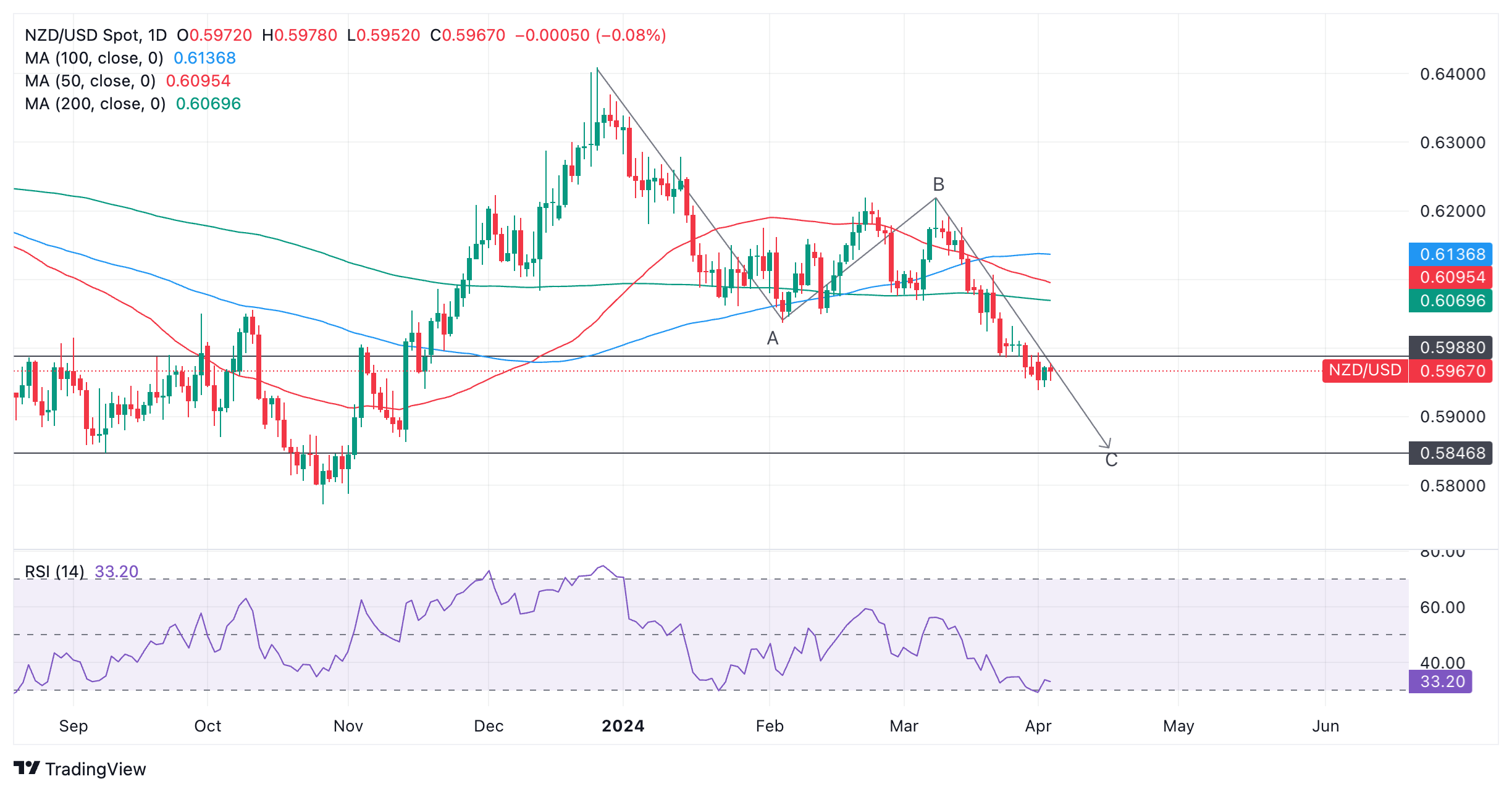New Zealand Dollar weakens further amid negative fundamentals
- The New Zealand Dollar extends its downtrend in most pairs as broadly weak fundamentals exert pressure.
- RBNZ governor Orr says the bank is “laser-focused” on beating inflation.
- Technically, price could be about to correct higher within a persistent downtrend.
The New Zealand Dollar (NZD) edges lower in its most heavily-traded pairs on Wednesday following the trend of the previous weeks as bearish fundamentals, including an overall negative outlook for growth, continue to weigh.
Recent comments from the Reserve Bank of New Zealand (RBNZ) Governor Adrian Orr failed to give the Kiwi much support, despite the prospect of the RBNZ maintaining relatively high interest rates. Orr stressed the importance of battling too-high inflation in a speech on Tuesday.
Normally higher interest rates help a currency as they attract more foreign capital inflows but in the case of New Zealand this does not appear to be the case. It is possible this is because the high inflation is accompanied by weak growth after the economy fell into a technical recession in the fourth quarter of 2023.
New Zealand Dollar in downtrend as negative fundamentals weigh
The New Zealand Dollar is under pressure. The latest figures from Statistics New Zealand showed the New Zealand economy contracted by 0.1% in Q4 of 2023 following a 0.3% contraction in Q3.
At the same time, headline inflation remained relatively high at 4.7% during the same reporting period, although it showed a slowdown from the 5.6% recorded in Q3.
Normally weak growth would call for lower interest rates. However, the Reserve Bank of New Zealand (RBNZ) cannot cut interest rates because of too-high inflation. Elevated price growth is partly a result of structural issues such as a tight labor market, which in turn keeps wage inflation high.
In his speech on Tuesday, Governor Orr said the RBNZ remains “laser-focused on its job to control inflation.”
“We're now in a much happier space, where most central banks feel we're back on top of inflation, [but we are] not there yet,” he added.
Technical Analysis: New Zealand Dollar could undergo a correction
NZD/USD is falling in the final wave C of a bearish three-wave pattern, known as a Measured Move. This type of pattern is made up of three waves, usually labeled ABC.
The end of wave C can be calculated because it is often the same length or a 0.618 Fibonacci ratio of wave A. According to that method of forecasting, wave C still has a way to go before completing.
New Zealand Dollar versus US Dollar: Daily chart
Assuming the pattern unfolds as expected, NZD/USD is likely to fall to a target at roughly 0.5847, corresponding to the end of wave C. It has already met the conservative target measured using the 0.618 Fibonacci ratio of wave A, at 0.5988.
The bearish outlook is complicated by The Relative Strength Index (RSI) momentum indicator, however, which briefly dipped into oversold territory on Monday and then recovered on Tuesday. The entry and then exit from oversold levels is a buy signal. It recommends that short sellers should close their bets and open longs. It suggests the possibility of a correction evolving.
It is therefore quite possible NZD/USD could undergo some upside before eventually continuing lower in line with the dominant downtrend, towards the target generated by the Measured Move.
New Zealand Dollar FAQs
The New Zealand Dollar (NZD), also known as the Kiwi, is a well-known traded currency among investors. Its value is broadly determined by the health of the New Zealand economy and the country’s central bank policy. Still, there are some unique particularities that also can make NZD move. The performance of the Chinese economy tends to move the Kiwi because China is New Zealand’s biggest trading partner. Bad news for the Chinese economy likely means less New Zealand exports to the country, hitting the economy and thus its currency. Another factor moving NZD is dairy prices as the dairy industry is New Zealand’s main export. High dairy prices boost export income, contributing positively to the economy and thus to the NZD.
The Reserve Bank of New Zealand (RBNZ) aims to achieve and maintain an inflation rate between 1% and 3% over the medium term, with a focus to keep it near the 2% mid-point. To this end, the bank sets an appropriate level of interest rates. When inflation is too high, the RBNZ will increase interest rates to cool the economy, but the move will also make bond yields higher, increasing investors’ appeal to invest in the country and thus boosting NZD. On the contrary, lower interest rates tend to weaken NZD. The so-called rate differential, or how rates in New Zealand are or are expected to be compared to the ones set by the US Federal Reserve, can also play a key role in moving the NZD/USD pair.
Macroeconomic data releases in New Zealand are key to assess the state of the economy and can impact the New Zealand Dollar’s (NZD) valuation. A strong economy, based on high economic growth, low unemployment and high confidence is good for NZD. High economic growth attracts foreign investment and may encourage the Reserve Bank of New Zealand to increase interest rates, if this economic strength comes together with elevated inflation. Conversely, if economic data is weak, NZD is likely to depreciate.
The New Zealand Dollar (NZD) tends to strengthen during risk-on periods, or when investors perceive that broader market risks are low and are optimistic about growth. This tends to lead to a more favorable outlook for commodities and so-called ‘commodity currencies’ such as the Kiwi. Conversely, NZD tends to weaken at times of market turbulence or economic uncertainty as investors tend to sell higher-risk assets and flee to the more-stable safe havens.







